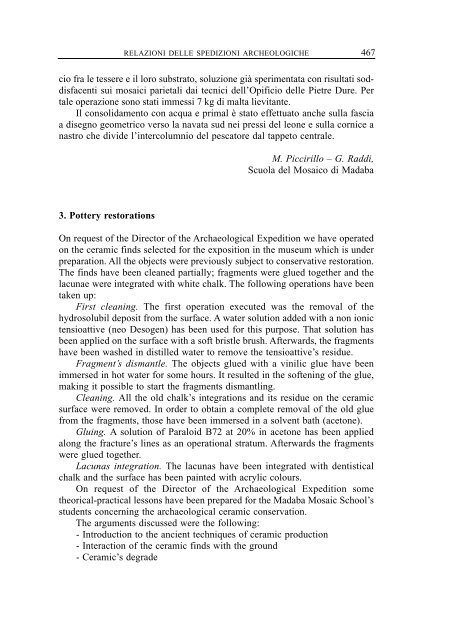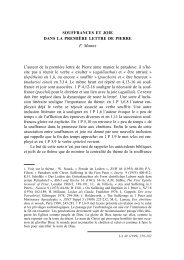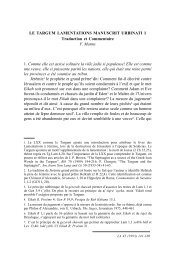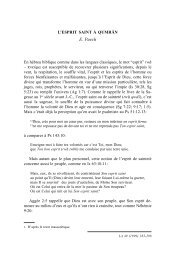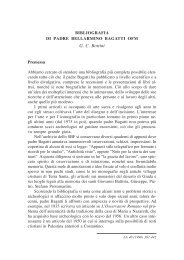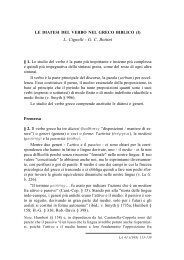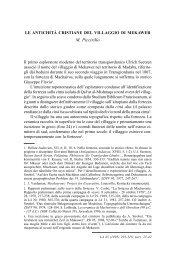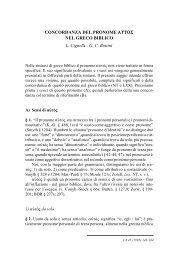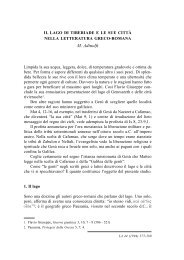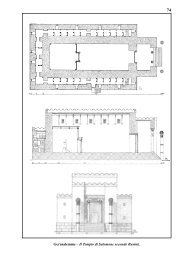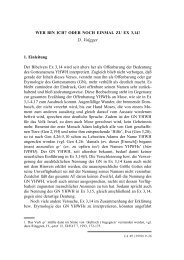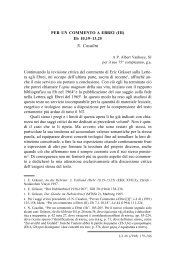Ricerca storico-archeologica in Giordania XVII – 1997
Ricerca storico-archeologica in Giordania XVII – 1997
Ricerca storico-archeologica in Giordania XVII – 1997
Create successful ePaper yourself
Turn your PDF publications into a flip-book with our unique Google optimized e-Paper software.
RELAZIONI DELLE SPEDIZIONI ARCHEOLOGICHE 467<br />
cio fra le tessere e il loro substrato, soluzione già sperimentata con risultati soddisfacenti<br />
sui mosaici parietali dai tecnici dell’Opificio delle Pietre Dure. Per<br />
tale operazione sono stati immessi 7 kg di malta lievitante.<br />
Il consolidamento con acqua e primal è stato effettuato anche sulla fascia<br />
a disegno geometrico verso la navata sud nei pressi del leone e sulla cornice a<br />
nastro che divide l’<strong>in</strong>tercolumnio del pescatore dal tappeto centrale.<br />
3. Pottery restorations<br />
M. Piccirillo <strong>–</strong> G. Raddi,<br />
Scuola del Mosaico di Madaba<br />
On request of the Director of the Archaeological Expedition we have operated<br />
on the ceramic f<strong>in</strong>ds selected for the exposition <strong>in</strong> the museum which is under<br />
preparation. All the objects were previously subject to conservative restoration.<br />
The f<strong>in</strong>ds have been cleaned partially; fragments were glued together and the<br />
lacunae were <strong>in</strong>tegrated with white chalk. The follow<strong>in</strong>g operations have been<br />
taken up:<br />
First clean<strong>in</strong>g. The first operation executed was the removal of the<br />
hydrosolubil deposit from the surface. A water solution added with a non ionic<br />
tensioattive (neo Desogen) has been used for this purpose. That solution has<br />
been applied on the surface with a soft bristle brush. Afterwards, the fragments<br />
have been washed <strong>in</strong> distilled water to remove the tensioattive’s residue.<br />
Fragment’s dismantle. The objects glued with a v<strong>in</strong>ilic glue have been<br />
immersed <strong>in</strong> hot water for some hours. It resulted <strong>in</strong> the soften<strong>in</strong>g of the glue,<br />
mak<strong>in</strong>g it possible to start the fragments dismantl<strong>in</strong>g.<br />
Clean<strong>in</strong>g. All the old chalk’s <strong>in</strong>tegrations and its residue on the ceramic<br />
surface were removed. In order to obta<strong>in</strong> a complete removal of the old glue<br />
from the fragments, those have been immersed <strong>in</strong> a solvent bath (acetone).<br />
Glu<strong>in</strong>g. A solution of Paraloid B72 at 20% <strong>in</strong> acetone has been applied<br />
along the fracture’s l<strong>in</strong>es as an operational stratum. Afterwards the fragments<br />
were glued together.<br />
Lacunas <strong>in</strong>tegration. The lacunas have been <strong>in</strong>tegrated with dentistical<br />
chalk and the surface has been pa<strong>in</strong>ted with acrylic colours.<br />
On request of the Director of the Archaeological Expedition some<br />
theorical-practical lessons have been prepared for the Madaba Mosaic School’s<br />
students concern<strong>in</strong>g the archaeological ceramic conservation.<br />
The arguments discussed were the follow<strong>in</strong>g:<br />
- Introduction to the ancient techniques of ceramic production<br />
- Interaction of the ceramic f<strong>in</strong>ds with the ground<br />
- Ceramic’s degrade


